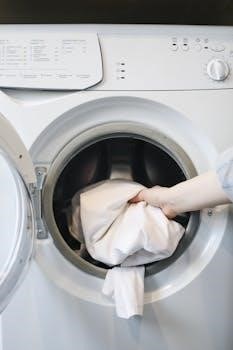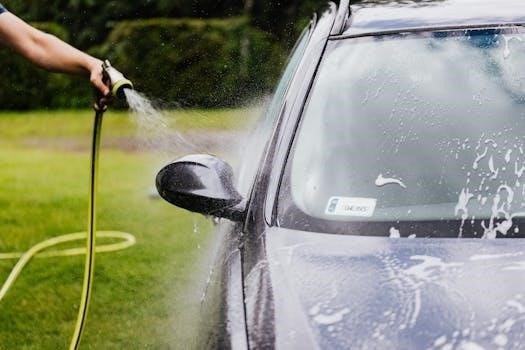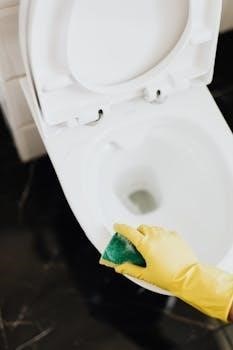
GE Self-Cleaning Oven Manual⁚ A Comprehensive Guide
This guide provides a comprehensive overview of using your GE self-cleaning oven. We’ll cover essential aspects‚ from safety precautions before self-cleaning to troubleshooting door latch issues and understanding the nuances of manual versus self-cleaning options. Accessing online manuals is also discussed.
Safety Precautions Before Self-Cleaning
Prior to initiating the self-cleaning cycle on your GE oven‚ it’s crucial to prioritize safety. First and foremost‚ ensure that all controls are turned off and the oven is completely cool. Never attempt to start the cleaning process while the oven is still hot. Clear the oven of all items‚ including racks‚ pans‚ and any foil‚ as these can be damaged by the high temperatures. It’s also essential to remove any items from the stovetop surrounding area‚ as the heat vents out of the oven. Avoid using oven cleaners or liners‚ as their residue can be harmful during the cleaning process. Consider ventilating your kitchen‚ by opening windows or using a ventilation hood because of the fumes produced during the self-clean cycle. Always adhere to the safety guidelines outlined in your specific GE oven manual to prevent any accidents or damage. Be aware that the oven door will lock during the process‚ and should not be forced open. Failure to follow these steps can result in damage to the oven or personal injury.
Removing Items Before Self-Clean Cycle
Before commencing the self-clean cycle on your GE oven‚ a thorough removal of all items from the oven interior is absolutely necessary. This includes all oven racks‚ which are typically made of shiny metal and not designed to withstand the extreme heat generated during self-cleaning. Broiler pans and grids must also be removed. Any cookware‚ baking sheets‚ or utensils left inside risk damage and can potentially warp or discolor. Furthermore‚ any aluminum foil‚ which is often used to catch drips‚ should be completely taken out. Leaving these items inside can also cause them to become fused to the oven’s interior‚ leading to additional cleaning difficulties down the line. Remember‚ the self-clean cycle operates at very high temperatures specifically designed to break down food residue. These temperatures are not safe for cooking equipment. Failure to remove all items can lead to damage and could void your oven’s warranty. Always double check that the interior is completely empty before starting the cycle.
Activating the Self-Clean Function
Activating the self-clean function on your GE oven is a straightforward process‚ but it requires careful attention to detail. First‚ ensure that the oven is completely empty‚ with all racks‚ pans‚ and other items removed. Next‚ locate the “Self Clean” button on your oven’s control panel; this is usually clearly labeled. Press the “Self Clean” button to begin the activation process. Following this‚ the oven’s display will typically show prompts guiding you through the remaining steps. These prompts might include options for selecting the duration of the cleaning cycle‚ depending on the level of grime in your oven. It is crucial to select the appropriate cycle duration as too short a cycle might not clean the oven thoroughly‚ while too long a cycle might be unnecessary. Once you have made your selection‚ press the “Start” button to begin the self-clean cycle. The oven door will then automatically lock‚ and the self-cleaning process will commence. Be aware that during this process‚ the oven will get very hot and you should not attempt to open the door until the cycle is finished and the door has unlocked.
Self-Clean Cycle Duration Selection
Selecting the appropriate duration for your GE oven’s self-clean cycle is essential for effective cleaning and maintaining the oven’s longevity. GE ovens typically offer multiple cycle duration options‚ which are designed to accommodate varying levels of grime and soiling inside the oven. A shorter cycle is suitable for ovens that only need a light clean‚ whereas a longer cycle is necessary for ovens with heavy buildup. When choosing the duration‚ consider how often you use your oven and how much food residue accumulates within. The control panel will display different options‚ usually in hours. It’s advisable to consult your oven’s manual for specific guidance on selecting the appropriate duration‚ as this can vary between different GE models. If you’re unsure‚ it’s often better to start with a shorter cycle and repeat it if needed rather than immediately opting for the longest duration. Keep in mind that longer cleaning cycles will use more energy and produce more heat‚ so choosing the correct cycle helps to avoid unnecessary energy consumption. Once you’ve selected the cleaning cycle‚ remember to press start and do not open the door until the cycle has finished.
Understanding the Door Locking Mechanism
The door locking mechanism on your GE self-cleaning oven is a critical safety feature designed to prevent accidental opening during the high-temperature self-clean cycle. This mechanism engages automatically when the cycle starts‚ ensuring that the oven door remains securely closed to contain the extreme heat. Typically‚ it involves a motorized latch that physically locks the door shut. When the self-clean cycle is activated‚ you’ll usually hear a distinct sound as the locking mechanism engages. The door will remain locked throughout the entire cleaning process and will only unlock once the oven has cooled down to a safe temperature. This feature is essential to protect you from potential burns and prevents damage to the oven’s components. It’s important not to try and force the door open while it is locked‚ as this could damage the locking mechanism. If the door remains locked after the cycle is complete‚ allow more time for the oven to cool. If the problem persists‚ consult your oven’s manual for troubleshooting advice or contact a qualified appliance technician. The locking mechanism is an important part of the oven’s safety system and understanding how it works is essential for its safe operation.
Troubleshooting a Stuck Door Latch
A stuck door latch on your GE self-cleaning oven can be a frustrating issue‚ typically occurring after a self-clean cycle. If the door remains locked after the cycle has finished and the oven has cooled‚ avoid forcing it open‚ as this can cause further damage to the locking mechanism. First‚ ensure the oven has completely cooled down‚ as the latch will not disengage until the temperature is safe. If the latch remains stuck‚ try turning off the circuit breaker to the oven for a few minutes‚ then turn it back on‚ this may reset the locking mechanism; If this does not work‚ consult the owner’s manual for specific troubleshooting steps for your model. In some cases‚ a manual latch release may be available. However‚ avoid using this unless you are sure of the correct procedure. If the issue persists‚ it is highly recommended to contact a qualified appliance technician who can diagnose and repair the problem without causing more damage. Attempting to fix a stuck latch yourself without the proper knowledge can lead to further complications and costly repairs. Always prioritize safety and consult professionals if necessary.
Manual Cleaning vs. Self-Cleaning Options
When it comes to cleaning your GE oven‚ you have two primary options⁚ manual cleaning and utilizing the self-cleaning feature. Manual cleaning involves using a damp cloth‚ possibly with mild dish soap‚ to wipe down the interior surfaces of the oven. This method is effective for light spills and regular maintenance‚ but it requires more physical effort and time. It is also recommended for ovens with special ceramic coatings‚ as harsh chemicals can damage these surfaces. On the other hand‚ the self-cleaning option‚ typically found in modern ovens‚ uses extremely high temperatures to burn off food residue and grease. This method is more convenient and efficient for heavy buildup. However‚ it requires removing all racks and cookware‚ and the oven door must be locked during the cycle. The self-cleaning cycle can also produce smoke and odors‚ necessitating proper ventilation. Ultimately‚ the best cleaning method depends on the severity of the mess and your personal preference‚ but both have their own advantages and disadvantages that must be considered. Always refer to your specific oven’s manual for the best cleaning practices to avoid potential damage.
The Dangers of Oven Cleaners and Liners
It is crucial to understand the potential hazards associated with using commercial oven cleaners and oven liners in your GE self-cleaning oven. Oven cleaners‚ especially those with harsh chemicals‚ can cause significant damage to the interior surfaces of your oven. The residue from these cleaners may not be completely removed and can react negatively with the high temperatures during the self-cleaning cycle‚ potentially releasing harmful fumes or causing corrosion. Furthermore‚ these chemicals can degrade any special coatings the oven may have‚ reducing its efficiency and lifespan. Similarly‚ oven liners‚ whether they are foil or other materials‚ pose a considerable risk. They can trap heat and cause uneven heating‚ potentially damaging the oven floor or heating elements. In addition‚ they can melt or release harmful substances at high temperatures‚ especially during the self-clean cycle. These materials can also interfere with the proper functioning of the oven’s safety mechanisms. Therefore‚ it is strongly advised against using any commercial oven cleaners or oven liners in GE self-cleaning ovens to maintain their integrity and safety.

Self-Cleaning Safe Components and Materials
When using the self-cleaning feature of your GE oven‚ it’s vital to understand which components and materials are designed to withstand the high temperatures involved. Typically‚ the oven’s interior walls‚ which often feature a specialized enamel coating‚ are built to tolerate the self-cleaning cycle. This coating helps to break down grease and food residue at high temperatures. However‚ it’s crucial to remove all removable parts such as oven racks‚ broiler pans‚ and any other cookware before initiating the cycle. These items are usually not made to withstand such high temperatures and can warp or discolor. Furthermore‚ any accessories made of aluminum or similar metals should be removed‚ as they are not considered self-cleaning safe and can cause damage to both the oven and themselves. Always refer to your specific GE model’s manual for a detailed list of safe and unsafe items. Generally‚ only the oven’s interior surfaces and any manufacturer-specified components are deemed safe for the self-cleaning cycle. It is important to note that any ceramic coating on the inside of the oven is designed to withstand the self-cleaning process.

Clock and Timer Settings
Setting the clock and utilizing the timer on your GE self-cleaning oven is a straightforward process‚ designed to enhance your cooking experience. To set the clock‚ typically you’ll need to press and hold the dedicated “Clock” button on the control panel until the time display begins to flash. Then‚ you can use the “+” and “-” buttons to adjust the hours and minutes to the correct time. Once set‚ press the “Clock” button again to save. The timer function‚ often used to time cooking or baking‚ typically involves pressing a “Timer” button‚ setting the desired time using the “+” and “-” buttons‚ and then pressing start. When the set time elapses‚ an audible signal will sound. These buttons are generally located on the control panel‚ next to the clock display. It’s crucial to refer to your specific GE model’s manual‚ as button layouts may vary; Some models may also have additional timer settings. You can also use this timer for other kitchen activities and not only for cooking. Make sure to always verify the current time before using the timer feature.

Accessing GE Manuals Online
Accessing your GE oven manual online is a convenient way to quickly find information and troubleshoot issues with your appliance. GE provides a variety of resources for obtaining digital copies of their manuals. One of the most common methods is to visit the official GE Appliances website. On the website‚ there’s typically a section dedicated to customer support or product manuals. You’ll usually be prompted to enter your specific model number‚ which is often located on a sticker on the oven itself. Once you’ve entered the model number‚ the site will provide a downloadable PDF version of the manual specific to your model. Additionally‚ some online retailers also offer GE manuals on their websites. You can also often find user manuals on third-party websites that specialize in hosting manuals for various appliances. Ensure that the sources you use are reputable and reliable. These online resources provide you with the most up-to-date version of your specific oven’s manual‚ which is crucial for accurate information and instructions. Having a digital copy allows you to easily search for specific keywords or sections as well.
